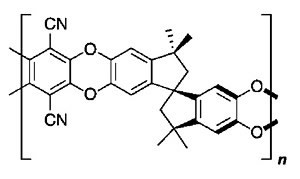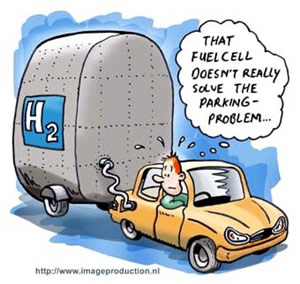UK chemists have devised a new approach to the storage of hydrogen gas that could power fuel-cell cars and vehicles without the need to carry hazardous cylinders of compressed gas. The approach is base on a highly porous polymer that can trap huge numbers of gas molecules allowing hydrogen gas to be stored in a compact container in a safe form.
Cardiff University’s Neil McKeown and collaborators Peter Budd of The University of Manchester, and David Book of the University of Birmingham are keen to solve the problem of hydrogen storage. The potential is enormous. As the use of fossil fuels comes under increasing environmental, political and practical pressures, alternative energy sources for use in vehicles and elsewhere will be needed in order to sustain current lifestyles. Fuel cells are considered one of the most promising alternatives to the internal combustion engine as they displace the pollution from city streets. The obstacle to their widespread use, however, lies in the need for a large energy-rich gas supply.

Polymer (Credit: Wiley/VCH)
Microporous materials can have a vast internal surface area relative to their overall volume and ones that can adsorb hydrogen molecules on to the inner surfaces of their pores offer a way to store the gas in a small space. Zeolites and activated carbons have been the focus of much of this research but cost and weight remain obstacles to their implementation in commercially viable systems. McKeown and his colleagues have developed an organic alternative based on polymers, which should be lighter as well as less expensive to mass produce.
The molecular chains in most organic polymers are flexible and can pack efficiently in tight structures. So, to make a porous polymer requires monomer building blocks that would result in inflexible chains. With this in mind, the team constructed polymers from molecules containing fused chemical rings that form a stiff strip. By introducing the occasional twist in the strip, the team could produce a contorted but stiff polymer structure. The contorted molecules cannot pack together efficiently and the results are tiny gaps between the chains. These polymers of intrinsic microporosity (PIMs) have a vast internal surface area. A gram of polymer has a pore surface area equivalent to three tennis courts, or 800 square metres, to which hydrogen molecules can stick.

Neil McKeown
The idea is to reversibly adsorb the hydrogen on to the high surface area offered by the polymer due to its microporous structure so that it can be stored at more reasonable pressures and temperature than is the case for gaseous or liquid hydrogen, McKeown told Spotlight, The polymer (or any other microporous material envisaged) would be expected to act like the petrol tank of a car and be able to adsorb and release the hydrogen many times, hopefully, over the whole lifetime of the car and perhaps beyond.

Cartoon used with permission of Peter Welleman, www.cartooncreator.nl
The researchers suggest that by 2010 they will have succeeded in optimizing their polymers to store 6% by weight of hydrogen. There is plenty of work to do before we get something practical, concedes McKeown, but the concept of PIMs gives chemists another route to investigate.
Further reading
Angewandte Chemie International Edition
http://dx.doi.org/10.1002/anie.200504241
Neil B. McKeown
http://www.cardiff.ac.uk/chemy/contactsandpeople/academicstaff/mckeown.html
Peter Budd
http://www.chemistry.manchester.ac.uk/aboutus/staff/showprofile.php?id=50
Dr David Book
http://www.eng.bham.ac.uk/metallurgy/staff/book.shtml
Cartoon fuel cell
http://www.cartooncreator.nl/images/fuelcell.jpg
Suggested searches
fuel cells
polymers